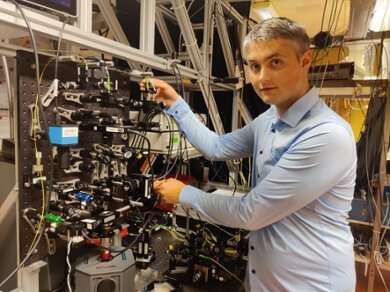This article has been reviewed according to Science X's editorial process and policies. Editors have highlighted the following attributes while ensuring the content's credibility:
fact-checked
trusted source
proofread
Physicists uses light to build complex structures

Ph.D. candidate Petr Steindl creates complex structures of light using single photons. As a teenager, he wanted to study Czech poetry but decided on quantum physics. "Looking back, I am glad I switched fields," he says. On July 5, he will defend his thesis on quantum optics and quantum dot systems.
"Simply speaking, a quantum dot is a little island of semiconducting material," Steindl says. "Because it is only a few nanometers in size it feels quantum effects, just like an atom." The researcher places this quantum dot in an optical microcavity to manipulate it more efficiently.
"You can imagine this cavity as two mirrors facing each other. Laser light bounces back and forth between them. The quantum dot does not like interacting with light, but the optical cavity makes it more likely because the laser passes the dot many times."
Using single photons like bricks in a house
This ingenious device can be used to create single photons, Steindl explains. "The resonant laser excites an electron in the quantum dot from its ground energy state to a higher one. When it falls back to the ground state, the quantum dot emits a single photon. The microcavity conveniently directs this photon toward the rest of our setup. The challenge, however, is to separate this photon from the laser light. It has the same wavelength as the laser but a slightly different polarization. You can exploit that property to isolate the photon. During my Ph.D., I explored and improved this technique."
Getting the single photons was only the first step in Steindl's research. "When you have high-quality single photons—particles of light—it's a bit like a brick," he says. "With bricks, you can start building a house. My goal was to combine individual photons to build complicated structures of light. For example, we created a chain of several entangled photons. Entangled means that they are so closely connected that you can't describe one photon independently from the other anymore. We want to understand these new states of light better."
The physics of single photons
Single photon physics is a relatively new field. In the 1970s, physicists managed for the first time to isolate a photon. However, these single-photon sources were not yet very efficient or robust. Technological developments like using the quantum dots in optical microcavities, have made it easier to control the production of single photons.
Another benefit of the microcavity is that the photon is ejected with a high velocity, ensuring it keeps its state better. This results in high-quality single photons that are well-suited for the structures Steindl works on.
Benefits for quantum technologies
The vision is to eventually use these novel light structures for quantum communication says Steindl. "We know that single photons are useful for security and authentication. For example, you can send two identical single photons from different locations on a beam splitter. If these photons arrive in an altered state or not simultaneously, you know there was an eavesdropper."
The research might also prove useful for building quantum computers. One fundamental component is a quantum gate, but they are hard to make. Those will not be necessary with the structures Steindl works on.
"I find it totally amazing to build these light structures," Steindl says. "The fact that it is possible to do this at all is mind-boggling. That we can understand physics at such a deep level. Although it is fascinating, the potential for quantum applications almost seems like a side-effect to me. Switching from literature to quantum was perhaps a big step, but it has been exciting enough to spend several years on and I'm not tired of it yet."
Provided by Leiden University





















